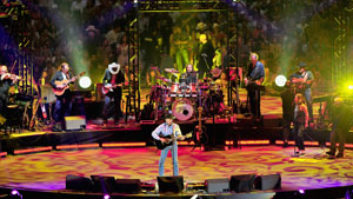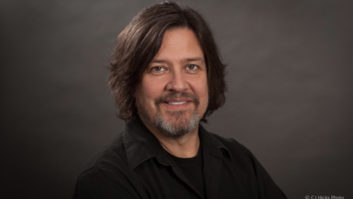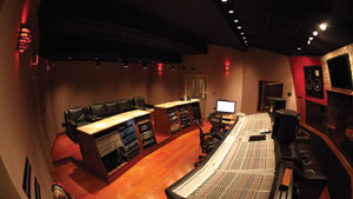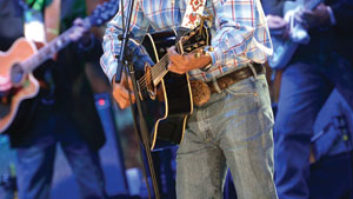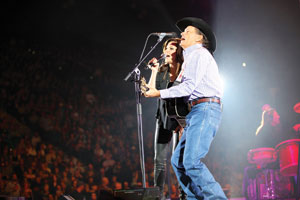
Martina McBride and George Strait
Photo by Jill Trunnell
The adulation for George Strait has to be experienced to be believed. The stats are amazing: 66 Number Ones, 20 Platinum records, 72,000-seat sellout in Houston this month. But numbers don’t prepare you for the roar that accompanies his entrance into an arena. It’s like teenage girls greeting N’Sync in 1999, no lie…except these are cowboys, and the roar has a bigger low-end.
This is after Martina McBride, a headliner in her own right who is opening 20 of the 21 dates, and who gets four to five standing-Os a night, gets in on the action, shouting out in the middle of her 70-minute set that she’s the luckiest girl in Nashville because “I get to open for George Freakin’ Strait!” At which point the crowd goes ballistic. Crazier than you’re even thinking right now.
You couldn’t ask for a better pairing at the start of this two-year “The Cowboy Rides Away” tour: Strait, one of the last of the cowboy troubadours, and McBride, who has always had one ear in Patsy Cline and another in today, with one of the most pure and powerful voices in any genre. On a recent three-day run of Sacramento-Fresno-Las Vegas arenas, the two worked up a two-song duet—“Jackson” and “Golden Ring”—and debuted them on the second night to thunderous applause; it was rumored to be the first time in over 30 years of touring that Strait has brought an artist on stage that he hasn’t made a record with. They are obviously having a ball on this last run through the States.
The P.A., always hung in the round for a George Strait show, was supplied and supported by Onstage Systems of Dallas. It’s an original V-DOSC rig, supplemented by the addition five years ago of alternating columns of Kudos, on an inside-outside configuration, two columns of each per side in the arena setup. There are four Lake LM44 processors running Lake Controller 6.0 with Smaart 7 analyzer bridge. Other than that, the audio setups couldn’t be more different between the two camps, with McBride on a decidedly analog signal chain, complete with wedges, and Strait on ears, with an all-digital FOH and monitor package.
George Strait’s audio crew at the Avid Profile, Las Vegas, from left: Fly and FOH tech Ernie Gonzalez; production manager Paul Rogers; FOH engineer and audio crew chief George Olson; monitor engineer Josh Kaylor.
Photo by Jill Trunnell
“We switched to the Avid Profile a few years ago, moving off the 5D, so George has been all-digital for a while now,” explains six-year Strait FOH mixer and audio crew chief George Olson, who works closely with Fly and FOH tech Ernie Gonzales. “We work pretty much entirely in the box. There are a lot of great plug-ins out there, but we’ve settled on the Maag EQ4 for vocal EQ on each of George’s four mics around the stage, then across that group of four I put a touch of McDSP ML4000 for compression, just to keep his voice up in the mix.
Martina McBride’s audio crew, at the ATI Paragon, from left: FOH engineer John McBride; Pro Tools and stage tech Allen Ditto; monitor tech Andre; FOH tech Arpad Sayko; monitor engineer Robert Bull.
Photo by Jill Trunnell
“Let’s face it, people come to hear that amazing voice,” he continues. “It’s a fantastic band, but I might get two minutes to get them where they need to be before George walks in and the crowd goes nuts. That’s actually the hardest thing! For the first two songs I’m just trying to relax and not fight the crowd. Keep the vocal on top, don’t push the band too much and let the crowd settle in. Then we have a great show!”
FOH and monitor consoles, both Profiles, are clocked externally with a Black Lion Audio Micro Clock. At monitors for Strait is Josh Kaylor, who says, “George has been using the Sennheiser G2 IEM system with Westone ES3 in-ear molds for about four years now. Unlike a lot of artists, he likes his mix to sound like the CD, so I like to keep things simple—there is a lot of room noise when you’re in the round, so I use zero effects and just a little LA-2A on his voice. For his two guitars we use the Shure UHF-R system. We have a Professional Wireless GX-8 combiner and two helical antennas for the ears. He sings into a hard-wired KSM9 capsule, one on every corner. When Martina took the stage with him, I just copied George’s mix and brought down guitars, fiddle, steel and the like. Then she just asked for a little more high end on her vocal and it went well. She can sing.”
John McBride, Martina’s husband and engineer, has been mixing her since the early 1990s, and the sound they have developed is as good as it gets live. McBride mixes at an ATI Paragon console, with a Midas sidecar for returns. He carries a rack filled with API mic pre’s and some standard effects, but to his left is a rack you won’t find on a lot of tours: two EMI TG12412 4-band EQs and two TG12413 limiters, along with a Neve 33609 compressor (“the metal knobs,” he insists) and a classic Klark-Teknik DN360 (“in 6dB mode”), all across the stereo bus.
McBride at his custom EMI rack, featuring the EMI TG12413 limiter and TG12412 4-band EQ, and Neve 33609 compressor.
Photo by Jill Trunnell
“It would be pretty hard to screw up Martina’s voice,” McBride laughs. “She sings into a Shure UHF-R wireless, SM58 capsule. From there it goes into an API 212 mic pre, then into the console, where I add a couple inserts—a dbx 160a compressor and a second ATI channel in a rack. Martina believes less is more when it comes to reverb. But I do sometimes use a Lexicon 480L. There’s a particular vocal plate that she likes.”
At monitors, also at an ATI Paragon, is longtime McBride colleague Robert Bull, known simply by his surname. For the in-the-round shows, he brings 18 of the original McBride MD1202 wedges, spaced at 20-degree intervals around the stage. “Her vocal comes in to the console, hits an API mic pre, gets a small bit of EQ and out it goes. No compression, ever! She needs to hear everything, but not in her face. You almost have to sneak it into her wedges as she moves; it’s a dance every night. Getting the wedges to work well together in the round, and with the house, is the daily challenge. But her band is amazing in how they almost mix themselves; all pretty straight-ahead for me.”
There is one more run of some 20 shows before The Cowboy Rides Away. This year’s version ends in his hometown of San Antonio to an expected sellout of 73,000. How many other artists can sell out a stadium on their own? Stellar performances, smokin’ hot bands, a couple of artists at their peak—it’s a show not to be missed.
